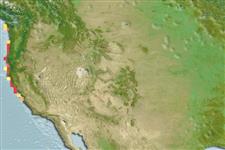>
Perciformes/Scorpaenoidei (Scorpionfishes) >
Sebastidae (Rockfishes, rockcods and thornyheads) > Sebastinae
Etymology: Sebastes: Greek, sebastes = august, venerable (Ref. 45335); diaconus: Name from Latinized ancient Greek διa;κονος, th, meaning an acolyte or assistant to a priest (complements S. mystinus which was intended to mean 'priest'; highlights the similarity between the 2 species and the previous lack of differentiation..
Environment: milieu / climate zone / depth range / distribution range
Ecología
marino asociado a arrecife; rango de profundidad 8 - 50 m (Ref. 103574). Subtropical; 48°N - 35°N (Ref. 103574)
Distribución
Países | Áreas FAO | Ecosistemas | Ocurrencias, apariciones | Point map | Introducciones | Faunafri
Eastern Pacific: from Vancouver Island in British Columbia to a southernmost record in Morro Bay, California
Length at first maturity / Tamaño / Peso / Age
Maturity: Lm 28.0 range ? - ? cm
Max length : 33.0 cm SL macho / no sexado; (Ref. 103574); edad máxima reportada: 32 años (Ref. 126416)
Short description
Claves de identificación | Morfología | Morfometría
Espinas dorsales (total) : 12 - 13; Radios blandos dorsales (total) : 14 - 17; Espinas anales: 3; Radios blandos anales: 8 - 9. This species is distinguished from its congeners, except S. ciliatus, S. melanops, S. mystinus, by having a dark gray, blue, brown, or black body coloration; scales on mandible; weak or no head spination; differs from S. ciliatus and S. melanops by the maxilla not extending beyond the posterior margin of the pupil when the mouth is closed; from S. ciliatusby having 4 bars of dark pigmentation that extend across the head and nape (vs. almost uniformly dark head coloration with 2 faint bars below the orbit) and with 26-27 vertebrae (vs. 28-29); differs from S. melanops by having a uniform, light blue-gray, speckled pattern on the trunk (vs. darker black-gray coloration with irregular areas of dark pigmentation ranging from speckling to blotches) and by having dark dorsal-fin membranes without dark spots; differs from S. mystinus by the brownish-blue to blue-gray trunk with distinct lighter blue-gray speckles (vs. steel-blue to greenish-blue body coloration and large, dark blotches which are also apparent in preserved specimens) - this character is indistinct in many individuals under 10.0 cm SL; differs from S. mystinus with individuals over 15.0 cm SL, by having the ventral margin of head and ventrum generally flat (vs. rounded) and by the allometric development of the symphyseal knob, length of dentary symphysis 4.0-7.0% HL (vs. 2.6-5.7% HL) - although these ratios overlap, the symphyseal knob length differs diagnostically among specimens of equal size over 15.0 cm SL (Ref. 103574).
Life cycle and mating behavior
Maturities | Reproducción | Spawnings | Egg(s) | Fecundities | Larva
Frable, B.W., D.W. Wagman, T.N. Frierson, A. Aguilar and B.L. Sidlauskas, 2015. A new species of Sebastes (Scorpaeniformes: Sebastidae) from the northeastern Pacific, with a redescription of the blue rockfish, S. mystinus (Jordan and Gilbert, 1881). Fish. Bull. 113:355-377. (Ref. 103574)
IUCN Red List Status (Ref. 130435)
Threat to humans
Harmless
Human uses
Herramientas
Special reports
Download XML
Fuentes de Internet
Estimates based on models
Phylogenetic diversity index (Ref.
82804): PD
50 = 0.5000 [Uniqueness, from 0.5 = low to 2.0 = high].
Bayesian length-weight: a=0.01000 (0.00499 - 0.02004), b=3.09 (2.92 - 3.26), in cm total length, based on LWR estimates for this Genus-body shape (Ref.
93245).
Nivel trófico (Ref.
69278): 3.7 ±0.5 se; based on size and trophs of closest relatives
Resiliencia (Ref.
120179): Medio, población duplicada en un tiempo mínimo de 1.4-4.4 años (Preliminary K or Fecundity.).
Fishing Vulnerability (Ref.
59153): Low to moderate vulnerability (30 of 100).
Nutrients (Ref.
124155): Calcium = 21.1 [6.6, 69.6] mg/100g; Iron = 0.393 [0.149, 1.017] mg/100g; Protein = 19.1 [17.9, 20.4] %; Omega3 = 0.385 [0.148, 0.999] g/100g; Selenium = 29.8 [10.1, 97.9] μg/100g; VitaminA = 119 [37, 382] μg/100g; Zinc = 0.619 [0.295, 1.211] mg/100g (wet weight);
